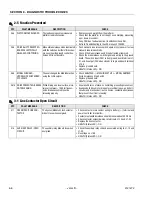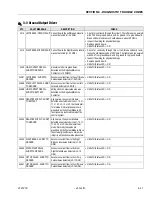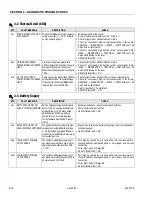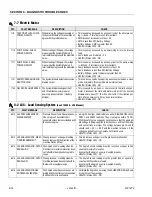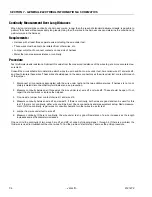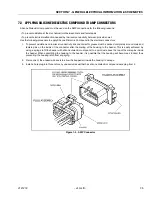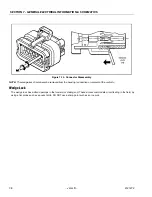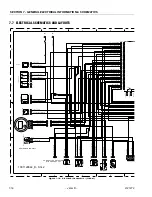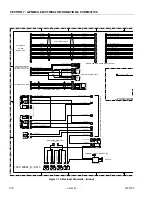
SECTION 7 - GENERAL ELECTRICAL INFORMATION & SCHEMATICS
7-4
– JLG Lift –
3121273
Continuity Measurement Over Long Distances
When trying to determine continuity of a harness or wire, longer than the reach of standard instrument leads, is possible to
perform the check without excessively long leads. Using the other wires in the harness one can determine the condition of a
particular wire in the harness.
Requirements:
• Harness with at least three separate wires including the wire under test.
• These wires must be able to be isolated from other wires, etc.
• Jumper or method to connect contacts on one side of harness.
• Meter that can measure resistance or continuity.
Procedure
Test multimeter leads resistance. Subtract this value from the measured resistance of the wires to get a more accurate mea-
surement.
Consult the circuit schematic to determine which wires to use in addition to wire under test, here called wire #1 and wire #2,
and how to isolate these wires. These wires should appear in the same connectors as the wire under test or are within reach
of the jumper.
1. Disconnect all connections associated with the wire under test and the two additional wires. If harness is not com-
pletely isolated disconnect battery terminals also, as a precaution.
2. Measure continuity between all three wires, the wire under test, wire #1 and wire #2. These should be open. If not,
repair the shorted wires or replace the harness.
3. On one side, jumper from contact of wire #1 and wire #2.
4. Measure continuity between wire #1 and wire #2. If there is continuity, both wires are good and can be used for this
test. If there is not continuity, either wire could be bad. Check connections and measurement setup. Redo measure-
ment. If still no continuity, repair wires or consult schematic for other wires to use for test.
5. Jumper from wire under test to wire #1.
6. Measure continuity. If there is continuity, the wire under test is good. Resistance of a wire increases as the length
increases and as the diameter decreases.
One can find the continuity of two wires, here #1 and #2, at once by following steps 1 through 4. If there is a problem the
third wire is used to troubleshoot the other wires. To find the problem, start at step 1 and use the entire procedure.



